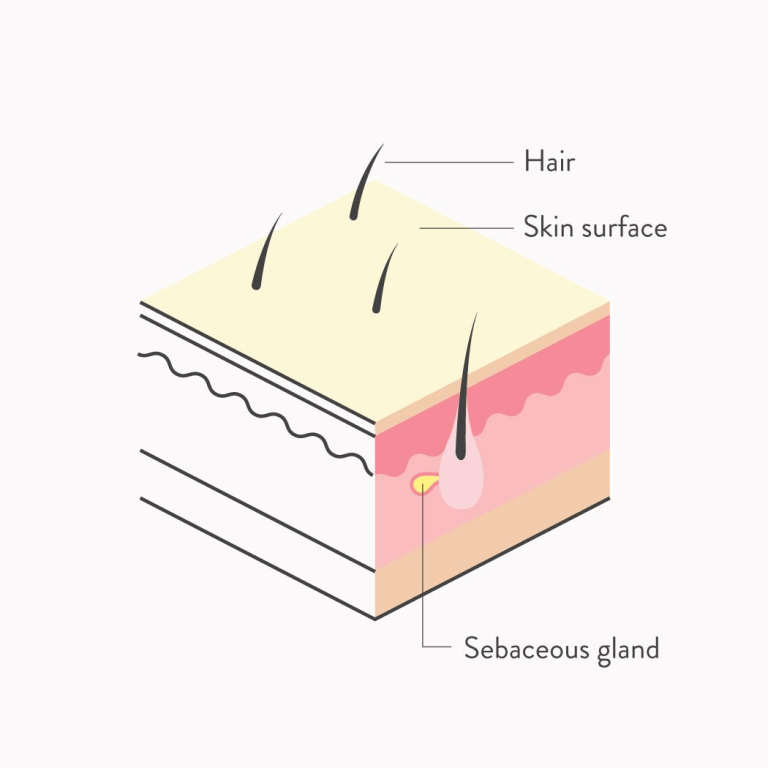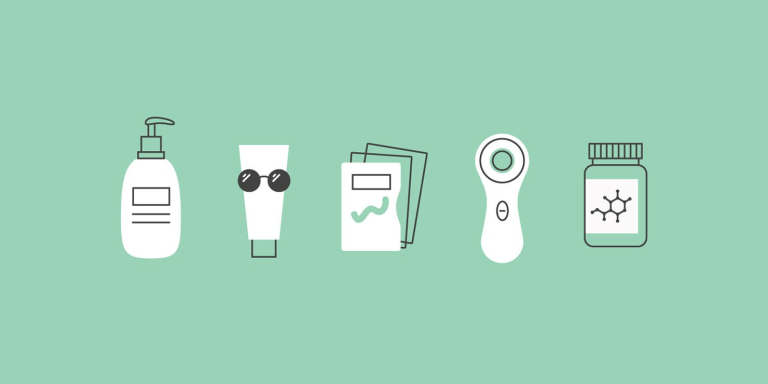How it works:
Share your skin goals and snap selfies
Your dermatology provider prescribes your formula
Apply nightly for happy, healthy skin
How it works:
How it works:
Share your skin goals and snap selfies
Your dermatology provider prescribes your formula
Apply nightly for happy, healthy skin
How it works:
Determining your skin type: oily skin
These skincare secrets can help decrease unwanted shine.



In this article
Ever notice your skin looking shiny even though you just washed it a few hours ago? Or do you ever feel like you should buy stock in blotting paper because you go through so much of the stuff? If so, chances are your skin is—newsflash, we know—oily. Oily skin is a common and completely normal characteristic. While people with oily skin often experience breakouts, there may be a plus side to having it. Oily skin may help slow the progression¹ of wrinkles more than other skin types. This may be because natural oils help keep your skin moisturized—even as you age.
Nonetheless, it never hurts to know how to help minimize excess oiliness. With these steps, you’ll not only learn how to manage oily skin but also how to help prevent excess oiliness.
What is oily skin?
Oily skin can happen when your sebaceous glands produce excess sebum. Sebum is a waxy, oily substance that moisturizes and protects your skin. Most of our sebaceous glands are located on the face and scalp,² which can lead to that shiny appearance that’s often noticeable on your T-zone. Sebum is definitely not a bad thing, but when combined with other elements like dead skin cells, it can clog pores and contribute to breakouts.

A lot of factors influence sebum production, thus contributing to oily skin. Sebum is largely regulated by androgens, hormones produced by your adrenal glands and in your ovaries or testes.³ A variety of factors influence androgen secretion including stress, diet, puberty, and the menstrual cycle. People with oily skin might have had a little help from their parents, too. That’s right. A study on identical and fraternal twins suggests that genetics may play a role in how oily your skin is.⁴
Here’s a closer look at factors that can contribute to oily skin.
Hormones. During periods of hormonal fluctuation (e.g., puberty, menstruation, pregnancy, and menopause) sebaceous glands can produce more oil under the influence of hormones (mainly androgens).⁵,⁶
Stress. Stress can make our bodies produce androgens, which can trigger sebum production.⁷
Diet. High glycemic foods (like sugar and simple carbs) and dairy can lead to oily faces. In some people, these foods may lead to the secretion of more sebum.⁸
Weather. As the temperature rises, oil glands tend to rev up!
How to know if you have oily skin?
If you have oily skin, chances are you’re already aware (when you know, you know). That said, do you know why oily skin is most common on the face? Oily skin is most visible on the face because that (along with your scalp) is where the majority of the skin’s sebaceous glands are located. Here are some signs you might have oily skin:
Shiny appearance. Even after washing, your face looks shiny. It also might have a greasy appearance later in the day.
Persistent pimples. The typical oily areas—nose, forehead, and chin—often have blackheads, pustules, or other types of acne.
Large pores. Visibly enlarged pores may be evident on the nose, forehead, and chin (and elsewhere on the face!).
Makeup slides off. Your makeup seems to melt off your face as the day goes on.
Five skincare tips for oily skin
You can do some things to manage oily skin that doesn’t require a doctor’s prescription and won’t break the bank.
Wash your face. This may seem obvious, but we’ll mention it anyway. Use a gentle cleanser and warm water to wash your face in the morning and at the end of the day, and be sure to also remove any makeup. Steer clear of products with ingredients that can irritate your skin. To avoid irritation, pat your face dry with a clean towel rather than rubbing it.
Use blotting papers. Blotting papers are specially designed to absorb sebum from the skin’s surface. They don’t reduce sebum production, but they’re a big help in removing excess oil. Plus, they’re easy to pack in your bag so you can use them on-the-go.
Apply moisturizers. This might seem counter-intuitive, but even with oily skin, you might still need to use a moisturizer for its hydrating effects. Choose an oil-free moisturizer that is non-comedogenic (non-pore-clogging).
Exfoliate. Use a gentle chemical exfoliator like 2% salicylic acid to remove dead skin cells. Salicylic acid is a beta hydroxy acid (BHA). BHAs are oil-soluble, so they get deeper into the pores than other chemical exfoliants (like AHAs).
Consider a mask. A simple DIY facial mask using ingredients like clay, honey, and oatmeal, can be great for oily skin. Clay can absorb oil, while colloidal oatmeal has anti-inflammatory properties,⁹ and honey has excellent natural antibacterial properties.¹⁰
How to help minimize oiliness?
We’ve all heard the phrase: Prevention is the best medicine. With that mantra in mind, here are some simple ways to help reduce oil production and control oily skin:¹¹
Use a foaming face wash. You don’t necessarily need a “strong” or “harsh” cleanser to get the job done. A gentle foaming face wash can cleanse your skin and help remove excess oil.
Avoid pore-clogging products. Select non-comedogenic products. Part of your skincare routine is cleansing, applying products—like Curology Custom Formula—and moisturizing. Whether you’re using our products or others that work for you, make sure they don’t have ingredients that clog pores. At the end of the day, try a micellar makeup remover.
Use water-based makeup. Many makeup products are oil-based and may make your skin seem greasier. Sometimes wearing no makeup at all is best for your skin. But if you want to wear makeup, consider choosing lighter, water-based products.
See a dermatology expert. Consulting with a healthcare expert can get you started on the right foot to put your best face forward (pardon the pun!).
Three ingredients to skip if you have oily skin
Many skincare products contain a lot of ingredients, so you’ll need to pay attention to the ingredients list to avoid buying something that will leave your skin even oilier. These three ingredients should generally be avoided if you’re trying to curb the oil in your skin.
Cocoa butter. It can wreak havoc on oily skin. Many dermatologists don’t recommend cocoa butter on acne-prone skin, as it can clog pores.
Coconut oil. Similar to cocoa butter, don’t use coconut oil if you’re prone to breakouts and have oily skin.
Alcohol. While alcohol is drying—which can be a good thing, depending on what it’s used for—it can be harsh on your skin.

Dermatologist-recommended products to treat oily skin
The amount of skincare products designed for oily skin is seemingly endless, but here’s a list of products we like to compliment your skincare routine and help with oily skin.
1. Cleansers
Cleansers with benzoyl peroxide or salicylic acid can help people with acne (including those with oily skin). Foaming cleansers may help dry things out.
2. Oil-free sunscreen
Sunscreen is your best protection against sun damage. You just need to make sure it’s non-comedogenic. The sunscreen by Curology is a 100% mineral-based broad spectrum SPF 30 formula that was designed by dermatologists to be safe for acne-prone skin. It’s currently available to members only, however you can sign up for a free trial of Curology if you’d like to test it out (more on this later). But if you’re still not a member and are looking for something you can grab over-the-counter, check out these two:
3. Oil-absorbing face sheets
If you’re looking for something to quickly soak up all that sebum, oil-absorbing face sheets are your go-to for being selfie-ready in seconds.
4. Exfoliators
Physical exfoliators help remove oil and dead skin cells. Chemical exfoliators do the same (remove dead skin) but with chemical compounds. Just remember to use exfoliators gently and no more than once or twice a week at first to help avoid skin irritation.
Konjac sponges (physical exfoliator)
The Ordinary AHA 30% + BHA 2% Peeling Solution (chemical exfoliator)
5. Niacinamide
Skincare products with this form of vitamin B3 may decrease oiliness.¹²
Take the guesswork out of skincare
If you’re struggling with oily skin, we feel you. But give yourself props! If you’ve read this far, that means you’re taking steps to educate yourself, and knowledge is power. Curology’s licensed dermatology providers work with a lot of common skin concerns like acne, hyperpigmentation, and rosacea and have helped many of our patients take control of their skin health. Give us a chance to help you. After you sign up, you’re paired with an in-house medical provider. They’ll evaluate your skin and skin goals to prescribe a Custom Formula with a mix of three active ingredients for your unique skin and your individual skincare concerns.
Get your personalized skincare routine with Curology
Get your personalized skincare routine with Curology


We also have a full line of skincare products to complete your routine, each designed by dermatologists to be non-comedogenic, dye-free, paraben-free, and hypoallergenic, made to keep your skin happy and healthy. Interested? You can get a free month of Curology*—just pay $5.45 (plus tax) to cover shipping and handling on your first box. After that, you can cancel at any time or choose the subscription plan that works for you.
FAQs
Oily skin can happen when your sebaceous glands produce excess sebum. Most of our sebaceous glands are located on the face and scalp, which can lead to that shiny appearance that’s often noticeable on your T-zone.
A lot of factors influence sebum production, thus contributing to oily skin.
Hormones. During periods of hormonal fluctuation sebaceous glands can produce more oil.
Stress. Stress can make our bodies produce androgens.
Diet. High glycemic foods (like sugar and simple carbs) and dairy can lead to oily faces.
Weather. As the temperature rises, oil glands tend to rev up!
Here are some signs you might have oily skin:
Shiny appearance. Even after washing, your face looks shiny.
Persistent pimples. The typical oily areas often have types of acne.
Large pores. Visibly enlarged pores may be evident on the nose, forehead, and chin.
Makeup slides off. Your makeup seems to melt off your face as the day goes on.
Here are some simple ways to help reduce oil production and control oily skin:
Use a foaming face wash.
Avoid pore-clogging products.
Use water-based makeup.
See a dermatology expert.
P.S. We did the homework so you don’t have to:
Tamatsu, Y., et al. New Finding that Might Explain Why the SKin Wrinkles More on Various Parts of the Face.Clinical Anatomy. (2015, July 1).
James G. Marks Jr MD, Jeffrey J. Miller MD, in Lookingbill and Marks' Principles of Dermatology (Sixth Edition), 2019
Hoover, E., et al. Physiology, Sebaceous Glands. In StatPearls. StatPearls Publishing. (2021).
Walton, S., Wyatt, E. H., & Cunliffe, W. J. Genetic control of sebum excretion and acne--a twin study. The British Journal of Dermatology. (1988).
Elsaie M. L. Hormonal treatment of acne vulgaris: an update. Clinical, cosmetic and investigational dermatology. (2016).
Cleaveland Clinic. Androgens. (n.d.).
American Academy of Dermatology. Adult acne. (n.d.).
Mahmood, S. N., & Bowe, W. P. Diet and acne update: carbohydrates emerge as the main culprit. Journal of drugs in dermatology. (2014)...
Kurtz, E. S., & Wallo, W. Colloidal oatmeal: history, chemistry and clinical properties. Journal of drugs in dermatology. (2007).
Mandal, M.D., et al. Honey: Its Medicinal Property and Antibacterial Activity. Asian Pacific Journal of Tropical Biomedicines. (2011, April).
American Academy of Dermatology. How to control oily skin. (n.d.)
Draelos, Z. D., et al. The effect of 2% niacinamide on facial sebum production. Journal of cosmetic and laser therapy : official publication of the European Society for Laser Dermatology. (2006).
This article was originally published on September 14, 2020 and updated on July 13, 2022.
* Subject to consultation. Subscription is required. Results may vary.

Curology Team

Kristen Jokela, NP-C
Related Articles
Which tretinoin is right for you, according to Vogue? How to help stop a rash from spreading, according to skin experts How to treat atrophic scars: Here’s what you need to knowThe relationship between skincare and mental healthFace sunscreen for dry skinPopular Articles
Ask Curology: Is my cold breaking me out?Slugging: The dermatologist-approved skincare hack going viral on TikTokTretinoin vs retinol: What’s the difference?How to create a self-care routine that actually sticksYour 2023 skincare horoscopeTry prescription skincare
Get routine essentials


Get clearer skin with Custom FormulaRX
Get clearer skin with Custom FormulaRX
- Breakouts
- Clogged pores
- Whiteheads
- Redness
- Blackheads
$29.95/month